Style
How the Work of the Late French Nouveau Réalisme Pioneer César Lives on Through a New Series of Pendants
The artist's foundation teamed up with Celine for the project.
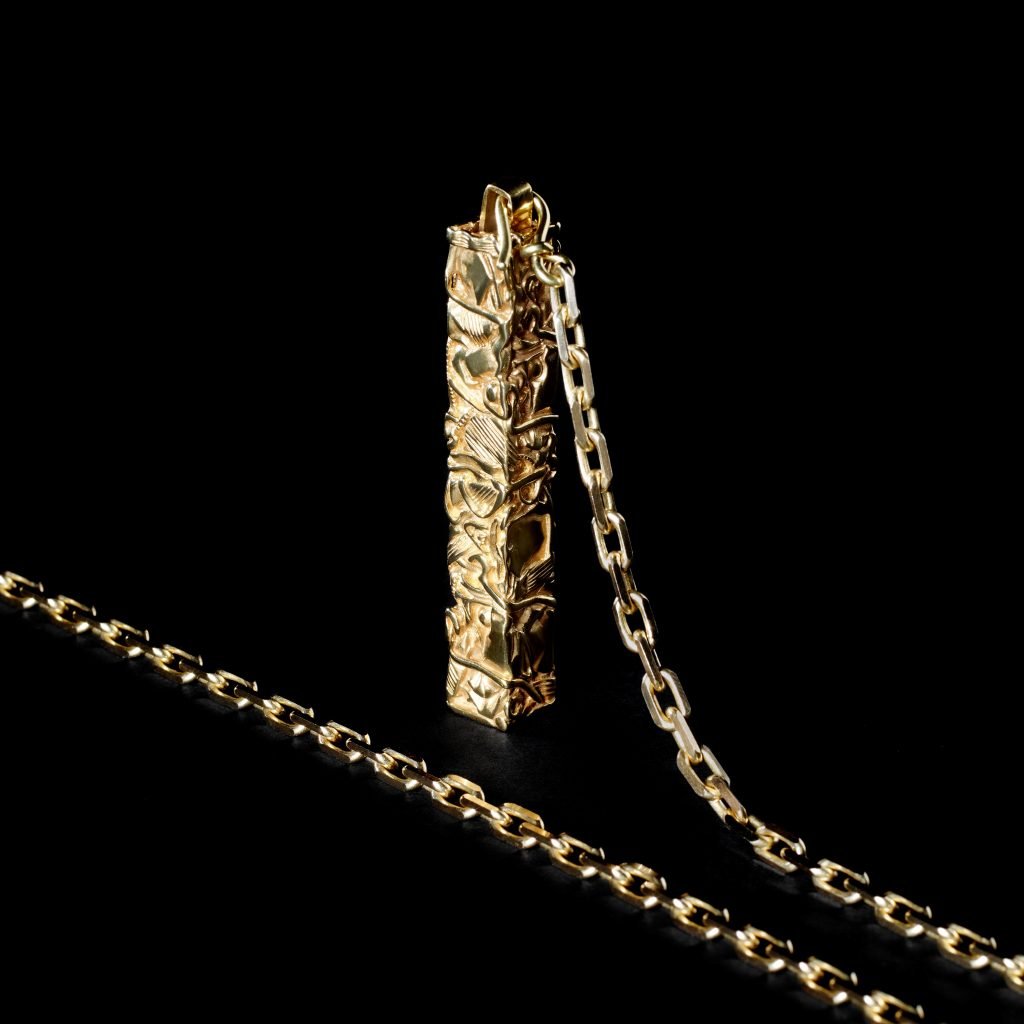
The artist's foundation teamed up with Celine for the project.

Noor Brara

Those familiar with César Baldaccini, who is often called only by his first name, know that the French artist and sculptor wasn’t particularly snobbish about the materials he used, and employed scrap metal, compacted automobile parts, newspaper, and found objects to create his radical sculptures.
Using a hydraulic press to steamroll and assemble his works, César enjoyed molding manmade materials into organic forms that resemble slabs of boulders or fauna in an effort to explore the liminal space between art and nature.
In many ways, his oeuvre fronted the Nouveau Réalisme movement of 1960s Paris, which sat at the intersection of the Italian anti-consumerist Arte Povera and the French Matieristes movements. His work was compared to Andy Warhol’s, yet César, who didn’t like labels, refused to liken it to that of any other artist or to adhere to the norms of the art world. A natural innovator who enjoyed working between creative fields, he explored his art through jewelry for many years, too, welding together older pieces of female friends’ to create something new.
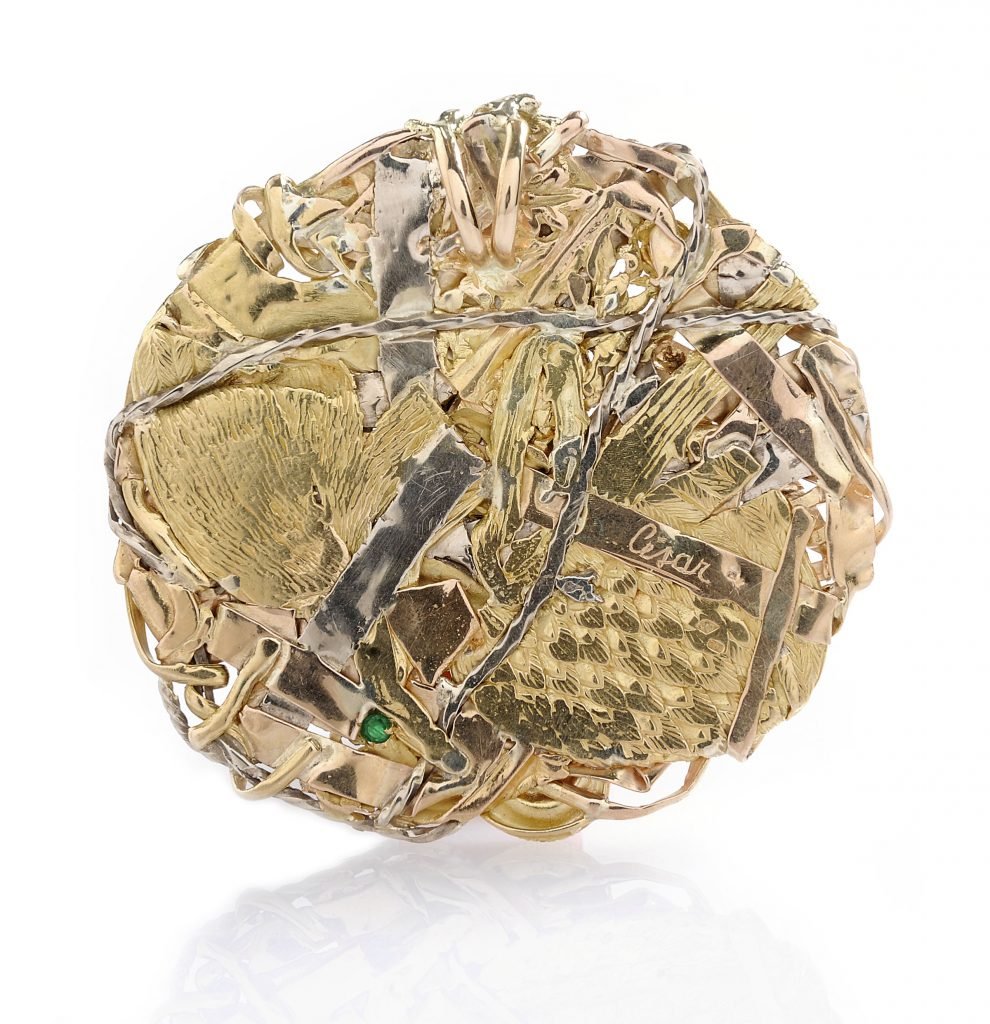
A closeup of a work by César (ca. 1980) illustrates the artist’s “compression” style of welding together various metals and materials. Photo courtesy Sorry We’re Closed.
This month, the artist’s freewheeling spirit is being celebrated through a unique collaboration between the Fondation César and Celine, the Paris-based couture house. It’s a project that César would have approved of, says Stephanie Busuttil-Janssen, Baldaccini’s former partner and the president of the foundation, which oversees his legacy and museum.
Earlier this year, Busuttil-Janssen, who worked with the artist during the last 10 years of his life, was contacted by Hedi Slimane at Celine to conceive a series of compression-style pendants that, at two and a half inches tall, are mini-versions of César’s unique sculptures. Over the course of a few months, the two joined forces to create 100 handmade, individual pieces, which are now available for sale via Celine’s website.
Just in time for the release of the collection, Busuttil-Janssen sat down with Artnet News to discuss the making of the collection, why it’s special to her, and how artist foundations can collaborate authentically with fashion brands.
How did this collaboration come to be?
I was contacted by Celine, and they told me that Hedi really wanted to do a project with César. You know, Hedi is an artist himself—I love what he did and what he has done for Celine, and feel that his collections are completely in line with the spirit of the foundation. His collections are grounded in the ’60s and ’70s attitude of Paris: very glamorous, all about artistic interests, that kind of spirit. It was really a way of life in Paris during that time, especially for César and his collectors. His work connects naturally to this brand—there is a shared view of the world. And we wouldn’t do something with a brand to which we have no connection. So, I decided to accept Hedi’s proposal.
How involved were you in the design process? Specifically, how did each involved party—your team at the foundation and the team at Celine—negotiate who would do what? Because this kind of collaboration, for which you essentially recreated smaller editions of César’s work, isn’t your average branded project.
It was very interesting because it was a really intimate process. To do it was solely Hedi’s choice, and nobody else at Celine really knew anything about the project—it was only the studio we were working with and their small team. It was basically our project. It was very involved, a real collaboration with their design team. They came to us in Brussels to discuss how I envisioned the project—in many ways, the foundation is really an extension of César’s studio because I ran the studio during the last years of his life. So I knew perfectly how he worked, and I had a lot of experience with his process and how he designed and made things. I’m still working with the same team, too. So the idea, for us, was not to say, “Let’s take one of César’s compressions and we’ll make a mould and we’ll get this project to Celine and they’ll take it from there.” It was really to do something special for Celine.
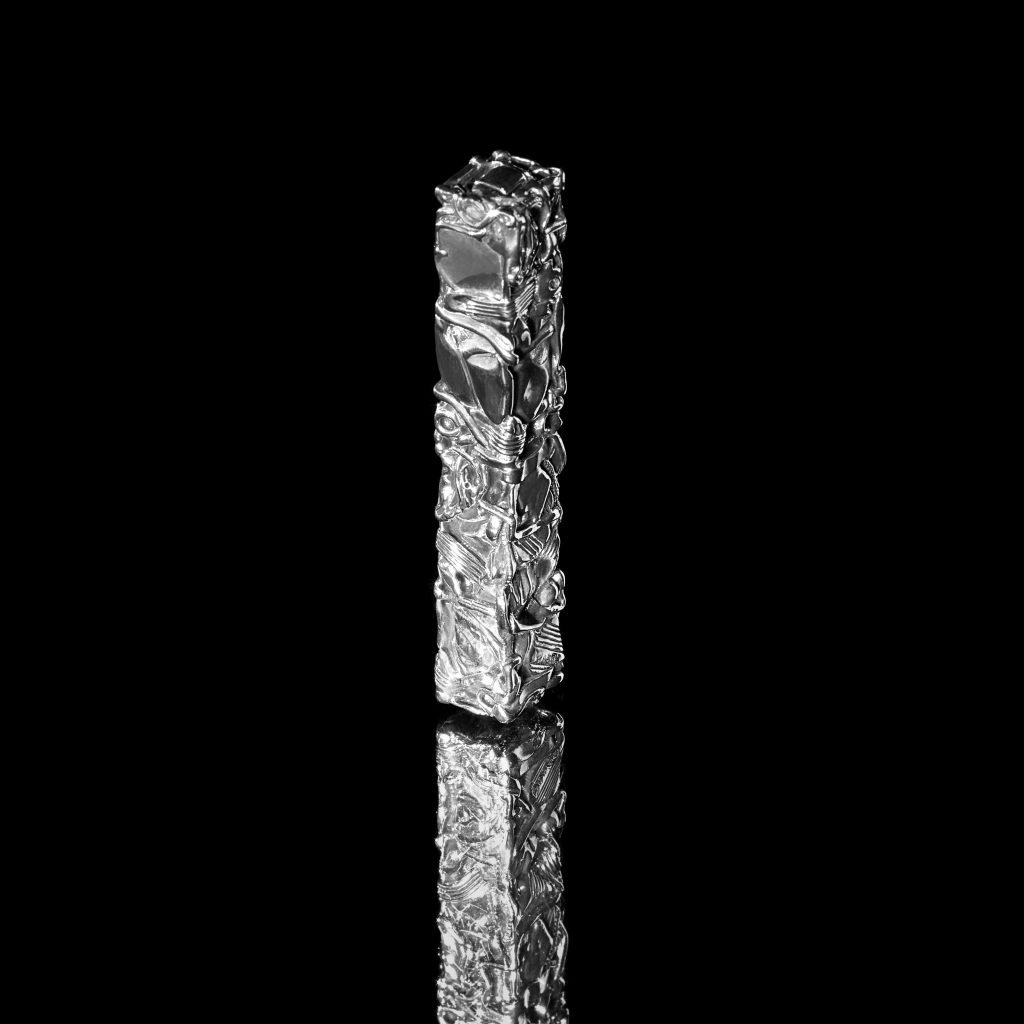
The Celine x Fondation César collaboration in silver. Photo courtesy Celine.
What came next, after you decided you’d make something original for Celine?
We used a compression—a vintage one from the ’70s—and I decided to change the size, and to use the foil that César had already used. We changed the size of the piece and created a new one through that change—a specific piece for this project that we conceived with our founder. Each piece was made by hand by an assistant and it’s a very small collection—only 100 editions. It was really like an art project that I could do with another “editor,” in a sense, and that was Hedi.
It was nice to collaborate with him because when you have an artist foundation, in a way you have a mission to popularize that artist and to continue to develop projects and to educate younger people about their work. And César was very close to a lot of fashion designers because at the end of the ’50s through the beginning of the ’70s, the center of Paris was still St. Germain-des-pres, where the Ecole Des Beaux Arts, the architecture school, and everyone was on one very small block. So all these people knew each other very well and Cesar did collaborations with architects and designers. There was a lot of bridge-building at that time.
And even though a César compression is normally totally unique, he had done, already, one edition that was moulded that looked a lot like the one we did for Celine. So I’m very comfortable with the piece itself, too. I’ve never done something that he’s never tried, and to have the Celine studio and Hedi on board with that ethos was really helpful. They were very really respectful.
We did the project very quickly, in two months. It was like ping-pong: they came to Brussels, then they went back to Paris, and do it all over again. They’d go in the night, they’d come back the day after—they went to the foundry and returned right away. It was very simple logically. I’m also especially proud of the packaging, the box.
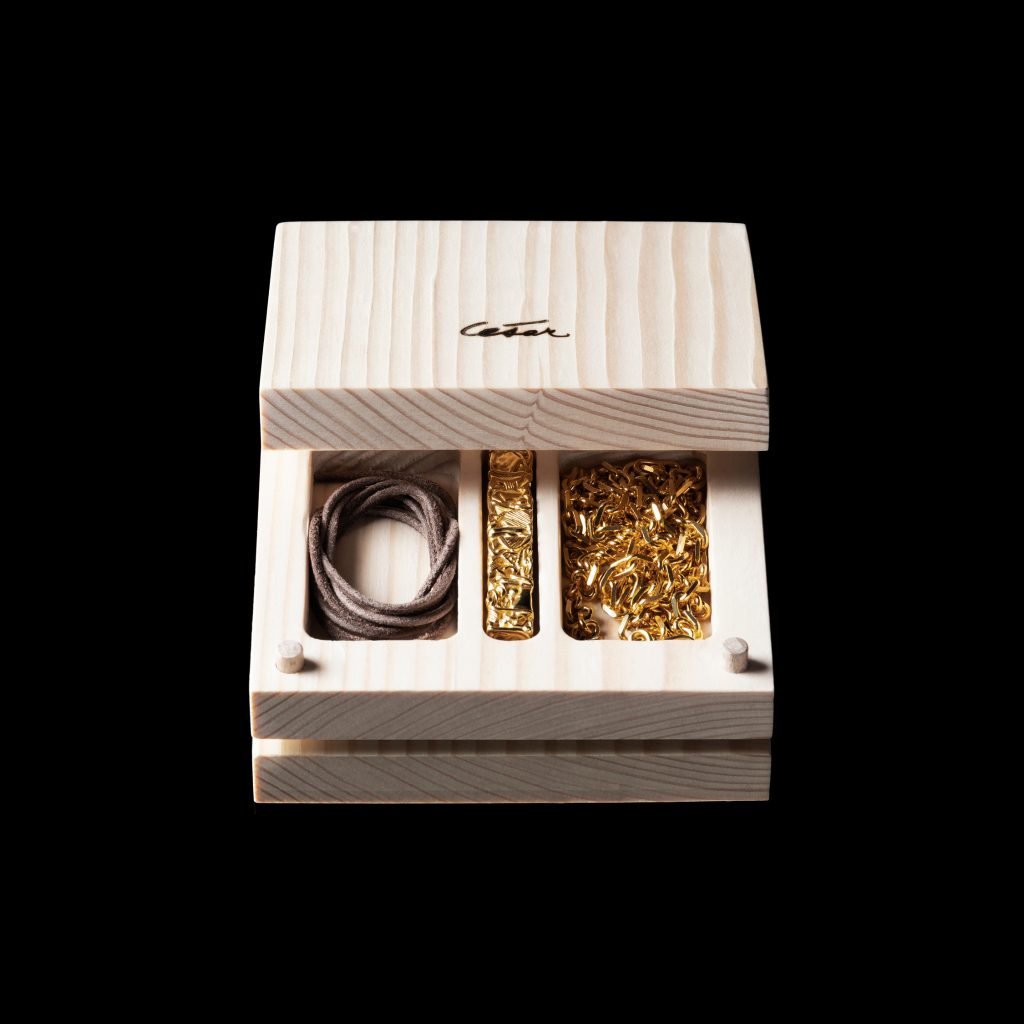
The Celine x Fondation César box was designed as a pedestal to display the pendant as a mini-sculpture. Photo courtesy Celine.
That box is great.
Thank you. It’s a design from the ’70s for a compression with pine wood, because César loved the opposition of rich material, like silver or gold, against the humble wood material of a box. You could use a box as a kind of pedestal, too, for the pendant. Because it’s really a wearable sculpture. There’s a hook at the top of the compression, which allows it to be propped up by the box if you want to display it on a side table or mantle or something. It becomes an art object.
I also didn’t know that César had such close ties to the fashion world.
Yeah, he was very, very close to Azzedine Alaia, in particular, and to Yves Saint Laurent.
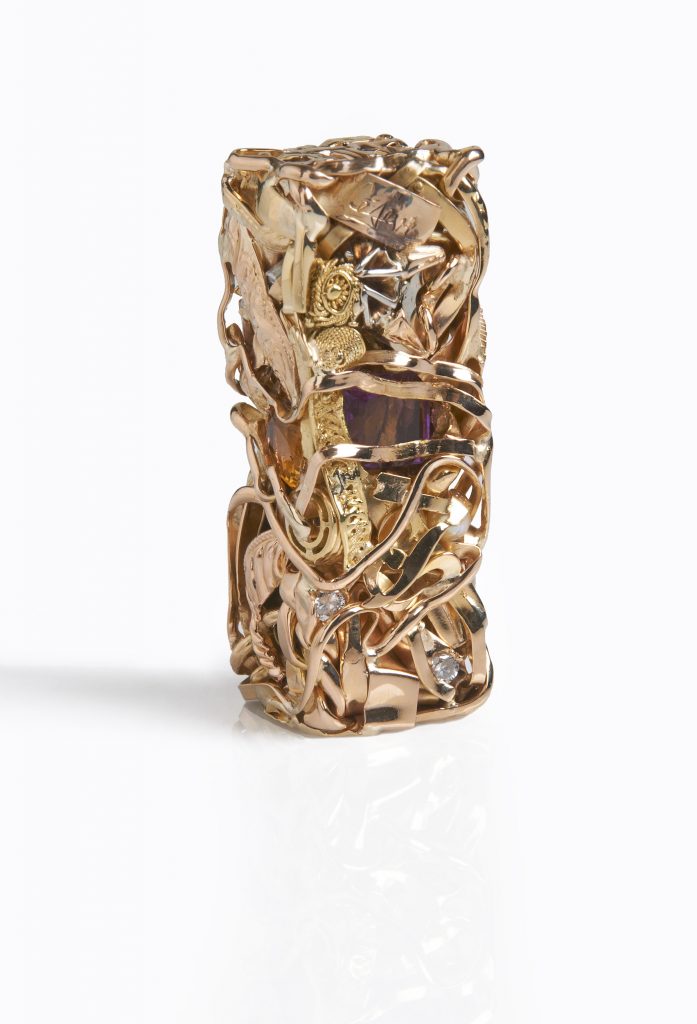
An original César piece. Photo courtesy Sorry We’re Closed.
What has the response to this project been like?
The reaction has been amazing and I’ve heard from a lot of people asking where they can buy a piece. I think they feel it’s a way to have a little bit of César’s work as well, which is hard to get because the original compressions are unique and therefore very expensive and rare. This is a piece of jewelry, but it’s also art at the same time. And to be honest, this edition is so well done that I think it’s one of the best César pieces I’ve seen yet. The chain is beautiful and the price is very correct for an edition of that level. And I was really precise about the choice in materials, because I wanted a specific weight. César was always explaining that when you’re wearing your compression, you have to wear it with a long chain because it gives you an attitude. The compression is very tactile, sexy, and there’s a weight to it. It’s strong. It’s meant to be worn on a long chain.
Any tips for other artist foundations looking to collaborate with big brands? Or vice versa?
Keep the projects genuine and authentic and be respectful of one another. It was so nice to work with people who were so kind and precise. To have the opportunity to work with a big brand—but really just their studio of five people—was amazing. It was very haute couture.